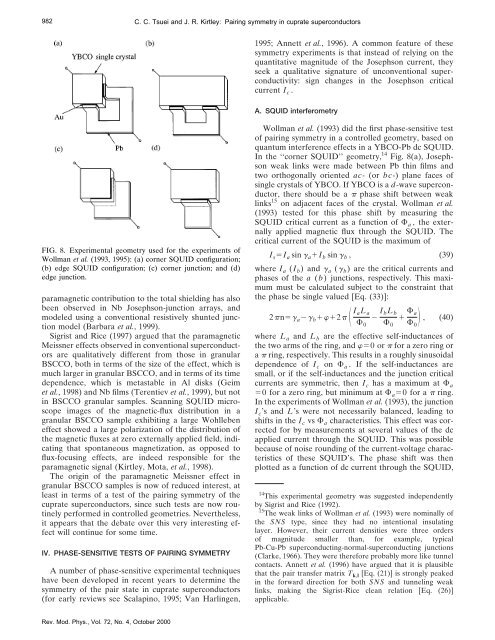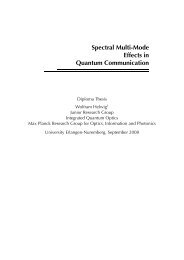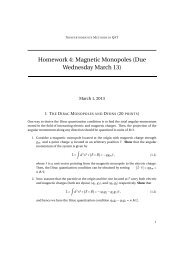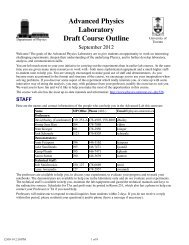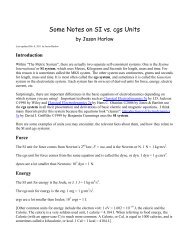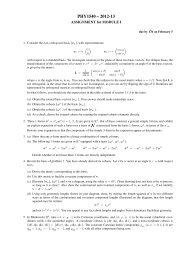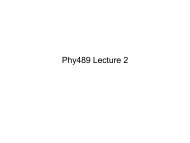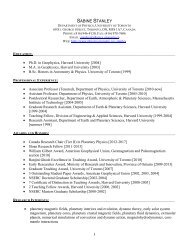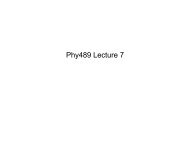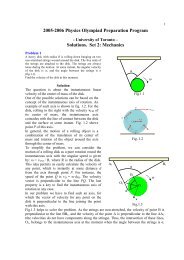Kirtley and Tsuei - Physics
Kirtley and Tsuei - Physics
Kirtley and Tsuei - Physics
You also want an ePaper? Increase the reach of your titles
YUMPU automatically turns print PDFs into web optimized ePapers that Google loves.
982 C. C. <strong>Tsuei</strong> <strong>and</strong> J. R. <strong>Kirtley</strong>: Pairing symmetry in cuprate superconductors<br />
1995; Annett et al., 1996). A common feature of these<br />
symmetry experiments is that instead of relying on the<br />
quantitative magnitude of the Josephson current, they<br />
seek a qualitative signature of unconventional superconductivity:<br />
sign changes in the Josephson critical<br />
current I c .<br />
A. SQUID interferometry<br />
FIG. 8. Experimental geometry used for the experiments of<br />
Wollman et al. (1993, 1995): (a) corner SQUID configuration;<br />
(b) edge SQUID configuration; (c) corner junction; <strong>and</strong> (d)<br />
edge junction.<br />
paramagnetic contribution to the total shielding has also<br />
been observed in Nb Josephson-junction arrays, <strong>and</strong><br />
modeled using a conventional resistively shunted junction<br />
model (Barbara et al., 1999).<br />
Sigrist <strong>and</strong> Rice (1997) argued that the paramagnetic<br />
Meissner effects observed in conventional superconductors<br />
are qualitatively different from those in granular<br />
BSCCO, both in terms of the size of the effect, which is<br />
much larger in granular BSCCO, <strong>and</strong> in terms of its time<br />
dependence, which is metastable in Al disks (Geim<br />
et al., 1998) <strong>and</strong> Nb films (Terentiev et al., 1999), but not<br />
in BSCCO granular samples. Scanning SQUID microscope<br />
images of the magnetic-flux distribution in a<br />
granular BSCCO sample exhibiting a large Wohlleben<br />
effect showed a large polarization of the distribution of<br />
the magnetic fluxes at zero externally applied field, indicating<br />
that spontaneous magnetization, as opposed to<br />
flux-focusing effects, are indeed responsible for the<br />
paramagnetic signal (<strong>Kirtley</strong>, Mota, et al., 1998).<br />
The origin of the paramagnetic Meissner effect in<br />
granular BSCCO samples is now of reduced interest, at<br />
least in terms of a test of the pairing symmetry of the<br />
cuprate superconductors, since such tests are now routinely<br />
performed in controlled geometries. Nevertheless,<br />
it appears that the debate over this very interesting effect<br />
will continue for some time.<br />
IV. PHASE-SENSITIVE TESTS OF PAIRING SYMMETRY<br />
A number of phase-sensitive experimental techniques<br />
have been developed in recent years to determine the<br />
symmetry of the pair state in cuprate superconductors<br />
(for early reviews see Scalapino, 1995; Van Harlingen,<br />
Wollman et al. (1993) did the first phase-sensitive test<br />
of pairing symmetry in a controlled geometry, based on<br />
quantum interference effects in a YBCO-Pb dc SQUID.<br />
In the ‘‘corner SQUID’’ geometry, 14 Fig. 8(a), Josephson<br />
weak links were made between Pb thin films <strong>and</strong><br />
two orthogonally oriented ac- (or bc-) plane faces of<br />
single crystals of YBCO. If YBCO is a d-wave superconductor,<br />
there should be a phase shift between weak<br />
links 15 on adjacent faces of the crystal. Wollman et al.<br />
(1993) tested for this phase shift by measuring the<br />
SQUID critical current as a function of a , the externally<br />
applied magnetic flux through the SQUID. The<br />
critical current of the SQUID is the maximum of<br />
I s I a sin a I b sin b , (39)<br />
where I a (I b ) <strong>and</strong> a ( b ) are the critical currents <strong>and</strong><br />
phases of the a (b) junctions, respectively. This maximum<br />
must be calculated subject to the constraint that<br />
the phase be single valued [Eq. (33)]:<br />
2n a b 2 I aL a<br />
0<br />
I bL b<br />
a<br />
0 0 , (40)<br />
where L a <strong>and</strong> L b are the effective self-inductances of<br />
the two arms of the ring, <strong>and</strong> 0 or for a zero ring or<br />
a ring, respectively. This results in a roughly sinusoidal<br />
dependence of I c on a . If the self-inductances are<br />
small, or if the self-inductances <strong>and</strong> the junction critical<br />
currents are symmetric, then I c has a maximum at a<br />
0 for a zero ring, but minimum at a 0 for a ring.<br />
In the experiments of Wollman et al. (1993), the junction<br />
I c ’s <strong>and</strong> L’s were not necessarily balanced, leading to<br />
shifts in the I c vs a characteristics. This effect was corrected<br />
for by measurements at several values of the dc<br />
applied current through the SQUID. This was possible<br />
because of noise rounding of the current-voltage characteristics<br />
of these SQUID’s. The phase shift was then<br />
plotted as a function of dc current through the SQUID,<br />
14 This experimental geometry was suggested independently<br />
by Sigrist <strong>and</strong> Rice (1992).<br />
15 The weak links of Wollman et al. (1993) were nominally of<br />
the SNS type, since they had no intentional insulating<br />
layer. However, their current densities were three orders<br />
of magnitude smaller than, for example, typical<br />
Pb-Cu-Pb superconducting-normal-superconducting junctions<br />
(Clarke, 1966). They were therefore probably more like tunnel<br />
contacts. Annett et al. (1996) have argued that it is plausible<br />
that the pair transfer matrix T k,l [Eq. (21)] is strongly peaked<br />
in the forward direction for both SNS <strong>and</strong> tunneling weak<br />
links, making the Sigrist-Rice clean relation [Eq. (26)]<br />
applicable.<br />
Rev. Mod. Phys., Vol. 72, No. 4, October 2000


